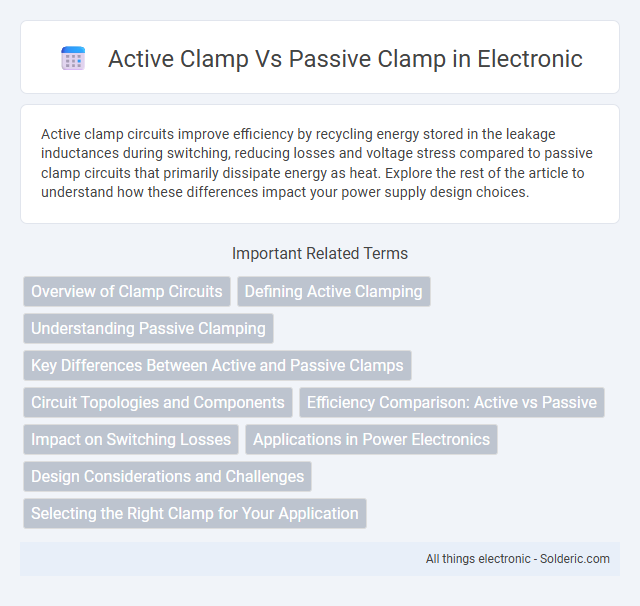Active clamp circuits improve efficiency by recycling energy stored in the leakage inductances during switching, reducing losses and voltage stress compared to passive clamp circuits that primarily dissipate energy as heat. Explore the rest of the article to understand how these differences impact your power supply design choices.
Comparison Table
| Feature | Active Clamp | Passive Clamp |
|---|---|---|
| Definition | Uses active components (transistors) to recycle energy and clamp voltage. | Uses passive elements (resistors, diodes) to clamp voltage without energy recovery. |
| Energy Efficiency | High efficiency due to energy recovery. | Lower efficiency; energy dissipated as heat. |
| Voltage Clamping | Precise and adjustable voltage clamping. | Less precise voltage clamping. |
| Complexity | More complex circuit design and control. | Simple, easy to implement. |
| Cost | Higher due to additional active components. | Lower cost with fewer components. |
| Thermal Management | Less heat generation; improved thermal profile. | More heat dissipation required. |
| Application | Used in high-efficiency power converters and switching power supplies. | Used in basic voltage clamping and protection circuits. |
Overview of Clamp Circuits
Clamp circuits regulate voltage levels to protect electronic components by limiting transient spikes. Active clamp circuits use additional semiconductor devices and control signals to recycle energy efficiently, reducing power loss and improving thermal performance. Passive clamp circuits rely on components like diodes and resistors, offering simplicity but often dissipating energy and generating more heat during operation.
Defining Active Clamping
Active clamping utilizes semiconductor devices such as transistors to control voltage spikes by temporarily storing and redirecting energy, enhancing efficiency and reducing stress on components. Passive clamping relies on fixed elements like resistors, capacitors, or diodes to absorb excess voltage without dynamic control, leading to higher energy losses and limited performance. Understanding active clamping helps you optimize power circuits by improving energy recovery and minimizing electromagnetic interference.
Understanding Passive Clamping
Passive clamping uses fixed components like resistors, capacitors, or diodes to limit voltage spikes and protect circuits without requiring external power or control signals. It relies on the inherent properties of these components to absorb or divert transient energy, making it simple and reliable for basic voltage protection needs. Understanding passive clamping helps you choose the right technique for safeguarding your electronics when efficiency and cost are priorities over dynamic control.
Key Differences Between Active and Passive Clamps
Active clamps utilize semiconductor switches to recycle energy and improve efficiency in power conversion systems, while passive clamps rely on passive components like resistors and capacitors to limit voltage spikes without energy recovery. Active clamps offer better voltage regulation, reduced switching losses, and enhanced thermal performance compared to passive clamps, which are simpler and less costly but less efficient. The choice between active and passive clamps depends on system complexity, cost constraints, and the need for higher efficiency and power density.
Circuit Topologies and Components
Active clamp circuits utilize semiconductor switches such as MOSFETs or IGBTs along with energy storage elements like capacitors to recycle leakage energy and improve efficiency, whereas passive clamps rely on passive components like diodes and resistors to absorb voltage spikes without active control. The active clamp topology typically features additional control circuitry enabling precise timing of switch operations, resulting in reduced switching losses and enhanced thermal performance. Your choice between active and passive clamp topologies significantly affects power conversion efficiency, component stress, and overall system reliability in switching power supplies.
Efficiency Comparison: Active vs Passive
Active clamp circuits offer higher efficiency compared to passive clamps by actively recycling energy during switching transitions, reducing power loss and heat generation. Passive clamps, relying on diodes or resistors, dissipate energy as heat, resulting in lower overall efficiency. In high-frequency power conversion applications, active clamps significantly improve efficiency by minimizing switching losses and enhancing energy recovery.
Impact on Switching Losses
Active clamp circuits significantly reduce switching losses by recycling the energy stored in the transformer's leakage inductance, which results in lower voltage stress and improved efficiency during the turn-off transition. Passive clamp circuits, on the other hand, dissipate this energy as heat through resistive elements, leading to higher switching losses and reduced overall converter performance. The implementation of active clamp technology is particularly beneficial in high-frequency power converters where minimizing switching losses is critical.
Applications in Power Electronics
Active clamp circuits are widely used in power electronics for their ability to improve efficiency and reduce voltage stress on switching devices, making them ideal for applications such as DC-DC converters and power supplies. Passive clamps, while simpler and more cost-effective, are commonly employed in lower-power or less sensitive applications where energy recovery and voltage spike suppression are needed but efficiency is less critical. Your choice between active and passive clamps will depend on the specific power electronics requirements, including efficiency targets, cost constraints, and system complexity.
Design Considerations and Challenges
Active clamp circuits require careful design to manage switching losses and ensure precise timing control, which improves efficiency but increases complexity and cost. Passive clamps offer simpler design and reliability by using resistors or diodes to absorb voltage spikes but can introduce higher power dissipation and reduced efficiency. Your choice depends on balancing design complexity, efficiency targets, and thermal management requirements in the application.
Selecting the Right Clamp for Your Application
Selecting the right clamp for your application involves evaluating efficiency, cost, and complexity. Active clamps offer higher efficiency and better voltage regulation in power supplies by recycling energy, making them ideal for high-performance or sensitive circuits. Passive clamps provide a simpler, cost-effective solution with fewer components, suitable for less demanding applications where size and cost are critical factors.
active clamp vs passive clamp Infographic

 solderic.com
solderic.com